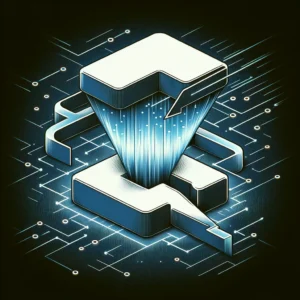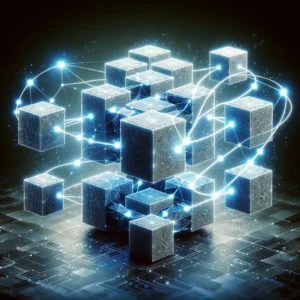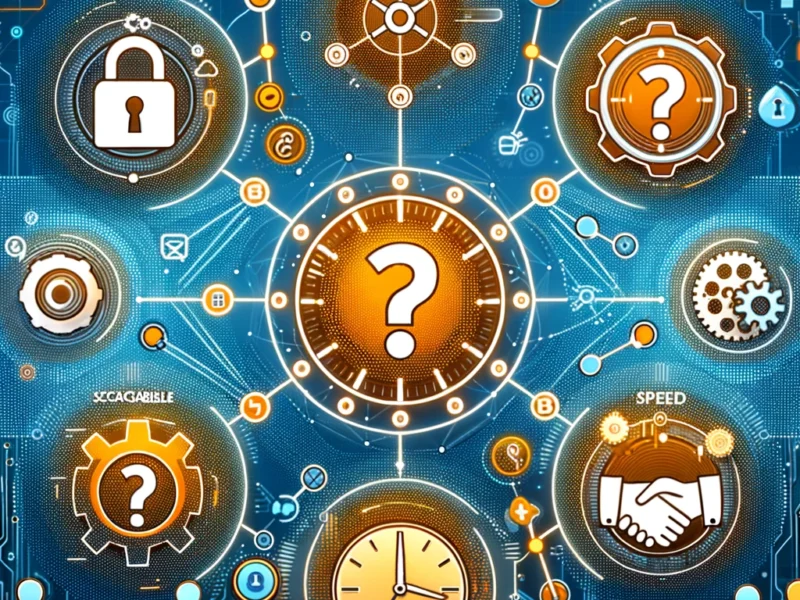If you’re a new investor, it might be difficult to understand the terms that seasoned investors use in the crypto, blockchain, and NFT communities.
But don’t worry; we’ve got you. Here are crypto, Web3 and blockchain terms you need to know.
1. Blockchain

Think of blockchain as a digital ledger, but supercharged. It’s decentralized, meaning no single entity controls it. Every transaction is recorded, creating an unchangeable history. It’s the backbone of cryptocurrencies and much more, paving the way for transparent and secure online transactions.
2. Cryptocurrency
Cryptocurrencies are digital currencies that use cryptography to secure transactions on the blockchain. Bitcoin and Ethereum are household names, but there are thousands more and they are a form of money that’s not tied to any government or institution.
3. Bitcoin
The first and most well-known cryptocurrency. Created by an anonymous entity named Satoshi Nakamoto, Bitcoin introduced the world to the power of blockchain. It’s more than digital money; it’s a technological breakthrough that challenges traditional financial systems.
4. Ethereum
Ethereum is not just a cryptocurrency; it is a whole platform. It’s where smart contracts come to life, allowing developers to build decentralized apps (dApps). Think of it as a playground for innovation in the blockchain space.
5. Smart Contracts
These are self-executing contracts with the terms directly written into code. They run on blockchain, meaning they’re secure and transparent. Smart contracts automate processes, cutting out the middleman and revolutionizing how agreements are made.
6. Decentralization
The essence of Web3 is decentralization—moving away from centralized control. Instead of one company or person holding the reins, control is spread across a network of users. This means more security, less censorship and a level playing field for everyone.
7. dApps (Decentralized Applications)

Imagine apps that run on a blockchain network instead of being hosted on centralized servers. These apps offer a new level of transparency and security. From games to finance, dApps are redefining what applications can do.
8. NFT (Non-Fungible Token)
NFTs are unique digital assets verified using blockchain technology. From art to music, they represent ownership or proof of authenticity for virtually anything. NFTs are a new investment opportunity for creators and collectors alike.
9. DAO (Decentralized Autonomous Organization)

This is a new model of organization, governed by its members and not centralized authorities. Decisions are made through consensus, often using tokens for voting rights. DAOs represent a radical shift in how organizations can operate.
10. DeFi (Decentralized Finance)
DeFi is a game-changer in the finance world. It’s about financial services, like borrowing, lending, and trading, operating on blockchain. DeFi platforms are accessible to anyone with internet access, challenging traditional banking systems.
11. Gas Fees
On the Ethereum network, transactions require processing power. Gas fees are payments made by users to compensate for the computational energy required to process and validate transactions on the blockchain. These fees can fluctuate based on network demand.
12. Wallet
In Web3, a wallet isn’t just for carrying cash or cards. It’s a digital tool that stores your cryptocurrencies and NFTs. More than a storage unit, wallets can interact with dApps, sign transactions, and manage digital identities.
13. Mining
Mining isn’t just for gold! In blockchain terms, it refers to the process of validating transactions and creating new blocks in the network. Miners use powerful computers to solve complex mathematical problems, earning cryptocurrency as a reward.
14. Proof of Work (PoW)
Proof of Work is a consensus mechanism used by Bitcoin and others to secure the network. Miners solve cryptographic puzzles to validate transactions and create new blocks. While secure, PoW is energy-intensive, sparking debates on sustainability.
15. Proof of Stake (PoS)
Currently used by the Ethereum blockchain, Proof of Stake is an alternative to PoW. In PoS, validators are chosen to create new blocks based on the number of coins they hold and are willing to “stake” as collateral. It’s more energy-efficient and is becoming increasingly popular.
16. Token
A token in crypto is a digital asset that can be traded, used, or held. They’re often built on existing blockchain platforms, like Ethereum. Tokens can represent anything from a currency to access rights and they’re essential in various blockchain applications.
17. ICO (Initial Coin Offering)
An ICO is a fundraising method for new projects. Companies issue tokens to investors in exchange for capital, typically cryptocurrencies. It’s similar to an IPO in the stock market, but in the decentralized and unregulated world of blockchain.
18. Altcoin
Any cryptocurrency other than Bitcoin is an altcoin. Ethereum, ARB and Litecoin are popular examples. These alternatives often try to improve upon Bitcoin’s technology or offer different features and use cases.
19. Stablecoin
Stablecoins are cryptocurrencies designed to have a stable value, often pegged to a currency like the US dollar or a commodity. They aim to combine the benefits of cryptocurrencies (like decentralization) with the stability of traditional currencies. USDT and USDC are perfect examples of stablecoins.
20. Fork
In blockchain, a fork happens when there’s a change in the protocol, leading to a divergence in the path of the blockchain. This can result in two separate chains with shared histories until the fork point. Forks can be planned (upgrades) or contentious (splitting communities).
21. Hash

A hash is a cryptographic function that converts an input (or ‘message’) into a fixed-size string of bytes. The output, typically a long string of numbers and letters, is unique to each input. Hashes are fundamental to ensuring blockchain security and integrity.
22. Public and Private Keys
These are a pair of cryptographic keys that enable secure transactions in the blockchain. The public key is like an address others can see, while the private key is a secret, similar to a password, used to sign transactions and access funds.
23. Layer 1
Layer 1 refers to the underlying main blockchain architecture. Bitcoin and Ethereum are examples of Layer 1 blockchains. Solutions at this layer include changes to the protocol to improve scalability, security and decentralization.
24. Layer 2
Layer 2 solutions are technologies developed on top of an existing blockchain (Layer 1) to improve scalability and efficiency. They handle transactions off the main chain, reducing congestion and fees. Examples include the Lightning Network for Bitcoin and Polygon for Ethereum.
25. Oracle
In blockchain, oracles are agents that find and verify real-world data and submit this information to the blockchain to be used by smart contracts. They bridge the gap between the digital and physical worlds, allowing smart contracts to interact with external data.
26. Smart Contract Auditing
This is the process of reviewing smart contracts for security flaws and vulnerabilities before they go live. Given the irreversible nature of blockchain, auditing is crucial to prevent potential hacks or exploits, ensuring the integrity and safety of decentralized applications.
27. Delegated Proof of Stake (DPoS)
A twist on Proof of Stake, DPoS allows token holders to vote for a few delegates who will secure the network on their behalf. This method aims to achieve a more democratic and efficient form of consensus in the blockchain world.
28. Sharding
Sharding is a scalability solution that splits a blockchain into smaller, more manageable pieces, or ‘shards’. Each shard contains its own data, making transactions faster and more efficient as the network grows.
29. Sidechain

A sidechain is a separate blockchain that is attached to the parent blockchain using a two-way peg. It allows tokens and other digital assets from the main blockchain to be securely used within the sidechain, increasing flexibility and scalability.
30. Lightning Network
Specifically for Bitcoin, the Lightning Network is a second layer that enables faster transactions. By creating channels off the main blockchain, users can transact swiftly and cheaply, solving some of Bitcoin’s scalability issues.
31. Genesis Block
The very first block in a blockchain is known as the genesis block. It’s the foundation upon which additional blocks are added, forming the blockchain. In Bitcoin, for example, the genesis block was created by Satoshi Nakamoto in 2009.
32. Hard Fork
A hard fork is a significant change to a network’s protocol that makes previously invalid blocks or transactions valid, or vice versa. This type of fork requires all nodes or users to upgrade to the latest version of the protocol software.
33. Soft Fork
Contrasting with a hard fork, a soft fork is a change to the software protocol where only previously valid blocks or transactions are made invalid. Since old nodes will recognize the new blocks as valid, a soft fork is backward-compatible.
34. Node
A node in blockchain technology is a point of connection that can receive, create, store and send data within the network. Each node helps maintain the blockchain, making it decentralized and robust against attacks or failures.
35. Consensus Mechanism
This is a core aspect of blockchain technology. It’s the process through which the nodes in a network agree on the state of the blockchain. PoW and PoS are examples, each ensuring agreement and consistency across the decentralized system.
36. Wallet Address
A wallet address is a unique identifier in the blockchain, similar to a bank account number. It’s used to receive and send cryptocurrencies and tokens. Secure and anonymous, these addresses are vital for transactions in the world of digital assets.
37. Hash Rate
The hash rate refers to the total computational power being used to mine and process transactions on a blockchain. It’s a key indicator of the network’s health and security. A higher hash rate means greater security and resistance to attacks.
38. Cold Wallet/Storage
A cold wallet (or cold storage) refers to keeping a cryptocurrency wallet offline, such as on a hardware wallet or paper wallet. It’s considered more secure than online storage (hot wallets) as it reduces the risk of hacking.
39. Hot Wallet
In contrast, a hot wallet is a cryptocurrency wallet connected to the internet. While they offer more convenience for frequent transactions, they are also more vulnerable to online threats like hacking and malware.
40. ERC-20
ERC-20 is a standard for creating and issuing tokens on the Ethereum blockchain. It defines a common list of rules that Ethereum tokens must adhere to, ensuring compatibility within the Ethereum ecosystem. Many digital assets and ICOs use the ERC-20 token standard.
41. ERC-721
Building on ERC-20, ERC-721 introduces a standard for non-fungible tokens (NFTs) on Ethereum. Unlike ERC-20 tokens, each ERC-721 token is unique and cannot be exchanged on a like-for-like basis, making them perfect for representing ownership of unique items.
42. Atomic Swap
An atomic swap is a technology that enables the exchange of one cryptocurrency for another without the need for a trusted third party or centralized exchange. It’s a critical feature for the decentralized trading of different digital assets.
43. Decentralized Exchange (DEX)
A DEX is an exchange that operates without a central authority. It allows users to trade cryptocurrencies directly with each other. Transactions on DEXs are facilitated by smart contracts and are known for enhanced privacy and security.
Uniswap, Pancakeswap and Quickswap are examples of a DEX.
44. Initial DEX Offering (IDO)
An IDO is a fundraising method where a project launches a token directly on a decentralized exchange. This method is favored for its open and immediate liquidity, lower costs and reduced risks of manipulation compared to traditional ICOs.
45. Governance Token
Governance tokens are digital assets that give holders voting rights over a blockchain project’s future. They’re a key part of many DAOs (Decentralized Autonomous Organizations), enabling a democratic approach to decision-making in the decentralized world.
46. Liquidity Pool
In the context of DeFi (decentralized finance), a liquidity pool is a collection of funds locked in a smart contract. These pools provide the necessary liquidity for decentralized exchanges and other financial applications, enabling efficient asset trading.
47. Yield farming
Yield farming is a popular strategy in DeFi, where users lock up their cryptocurrencies to earn rewards. By providing liquidity to a DeFi protocol, users can earn interest or tokens, often resulting in high returns compared to traditional investments.
48. Testnet

Contrasting with the mainnet, a testnet is a trial version of a blockchain used for testing. It’s an essential part of development, allowing for experiments and adjustments without affecting the main network. Testnet coins have no real value.
49. Staking
Staking involves holding funds in a cryptocurrency wallet to support the operations of a blockchain network. In return for their contribution, stakers receive rewards, typically in the form of additional cryptocurrency. It’s a key component of proof-of-stake (PoS) systems.
50. Wrapped Tokens
Wrapped tokens are cryptocurrencies pegged to the value of another cryptocurrency. They’re created to be used on a blockchain different from the one they originally belong to. For example, wrapped bitcoin (WBTC) allows bitcoin to be used on the Ethereum blockchain.
51. Cross-Chain
Cross-chain refers to the ability to interact with and transfer data or value between different blockchain networks. This technology is crucial for interoperability, allowing diverse blockchain systems to work together and share information seamlessly.
52. Layer 0
Layer 0 is a foundational network layer that underpins higher-level blockchain networks (like Layer 1 and Layer 2). It provides the basic infrastructure for different blockchains to interoperate and scale effectively.
53. Tokenomics
Tokenomics encompasses the economics of a token, including its distribution, supply mechanics, and how it can create value within its ecosystem. Understanding tokenomics is vital for assessing the long-term viability and success of a cryptocurrency.
54. Cryptographic Signature
A cryptographic signature is a mathematical scheme for verifying the authenticity of digital messages or documents. It’s similar to a digital fingerprint, providing secure proof of ownership and preventing forgery in transactions.
55. Metaverse

The metaverse is a collective virtual shared space created by the convergence of virtually enhanced physical reality and persistent virtual spaces. In Web3, it represents an immersive digital world built on blockchain technologies where users can interact, play and transact.
56. Zk-SNARKs (Zero-Knowledge Succinct Non-Interactive Arguments of Knowledge)
Introduced in a 2012 paper co-authored by Nir Bitansky, Ran Canetti, Alessandro Chiesa, and Eran Tromer, Zk-SNARKs are a form of cryptography used in blockchains for enhanced privacy. They allow one party to prove to another that they know a value without revealing any information about that value.
57. Flash Loans

Unique to DeFi, flash loans are uncollateralized loans that must be borrowed and repaid within the same blockchain transaction. They’re used for various purposes, including arbitrage and swapping collateral on other DeFi platforms.
58. Gas Limit
The gas limit is the maximum amount of gas a user is willing to spend on a transaction on the Ethereum network. Setting the right gas limit is crucial; too low, and the transaction fails; too high and you overpay.
59. Multi-Signature Wallet
A multi-signature (multi-sig) wallet requires multiple private keys to authorize a cryptocurrency transaction. This added layer of security is useful for teams or organizations that need more than one person to approve transactions.
60. Mainnet
A mainnet is the final and official version of a blockchain where actual transactions take place on the distributed ledger. It’s the live network, where the cryptocurrency of the network holds real economic value.
61. On-Chain Governance
On-chain governance involves managing and implementing changes to a blockchain protocol directly on the chain through its own set of rules. This process is often democratic, involving voting by stakeholders.
62. Off-Chain Governance
Off-chain governance takes place outside the blockchain. It includes decisions and actions by the community, developers and other stakeholders through forums, meetings, and other traditional decision-making processes.
63. Interoperability
Interoperability refers to the ability of different blockchain systems to work together. It’s crucial for broader adoption, allowing for seamless exchanges of information and value across diverse netwrks and applications.
Frequently Asked Questions
1. What is blockchain and why is it important?
A blockchain is a decentralized digital ledger that records transactions across many computers. It’s important because of its ability to ensure transparency, security, and integrity of data without the need for a central authority, revolutionizing fields like finance, supply chain management, and more.
2. How do cryptocurrencies work?
Cryptocurrencies are digital or virtual currencies secured by cryptography, which makes them nearly impossible to counterfeit. They operate on blockchain technology to facilitate secure and anonymous transactions.
3. What is the difference between Bitcoin and Ethereum?
Bitcoin was the first cryptocurrency and is primarily used as a digital currency and store of value. Ethereum, on the other hand, extends beyond being a digital currency by providing a platform for executing smart contracts and building decentralized applications (dApps).
4. What are smart contracts and their use cases?
Smart contracts are self-executing contracts with the terms of the agreement directly written into code. They automate execution, reduce reliance on intermediaries, and find use cases in various sectors, including finance, real estate, and legal processes.
5. Can you explain the concept of decentralization in Web3?
Decentralization refers to the distribution of control and authority across a network rather than centralizing it within a single entity. In the context of Web3, it means that no single entity controls the internet or its services, promoting a more democratic and secure digital space.
6. What are dApps and how do they differ from traditional apps?
Decentralized applications (dApps) are digital applications that run on a blockchain network, ensuring they operate in a transparent, secure, and censorship-resistant manner. Unlike traditional apps, which are controlled by a single entity, dApps are governed by the consensus of their users.
7. How do NFTs function and what are their applications?
Non-Fungible Tokens (NFTs) are blockchain-based digital assets that represent ownership or proof of the authenticity of unique items. They’re used in art, music, gaming, and more, allowing creators to monetize their work directly.
8. What is a DAO and how does it work?
A decentralized autonomous organization (DAO) is an organization represented by rules encoded as a computer program that is transparent, controlled by organization members and not influenced by a central government. DAOs are effectively managed by their members, who make decisions collectively through voting.
9. What is DeFi and what are its advantages over traditional finance?
Decentralized Finance (DeFi) refers to financial services, including borrowing, lending, and trading, that operate on blockchain technology without traditional intermediaries. DeFi offers more accessibility, transparency, and efficiency than conventional banking.
10. What are gas fees in the context of blockchain?
Gas fees are payments made by users to compensate for the computational energy required to execute transactions or smart contracts on a blockchain network, primarily associated with Ethereum. They vary based on network congestion and transaction complexity.
11. What are the uses of a cryptocurrency wallet?
A cryptocurrency wallet is a digital tool that stores public and private keys used to receive and send cryptocurrencies. It’s essential for managing and securing digital assets and interacting with blockchain networks.
12. What is the difference between Proof of Work and Proof of Stake?
Proof of Work (PoW) requires miners to solve complex mathematical puzzles to validate transactions and create new blocks, consuming significant energy.
Proof of Stake (PoS) selects validators based on the number of coins they hold and are willing to “stake” or lock up, which is more energy-efficient.










